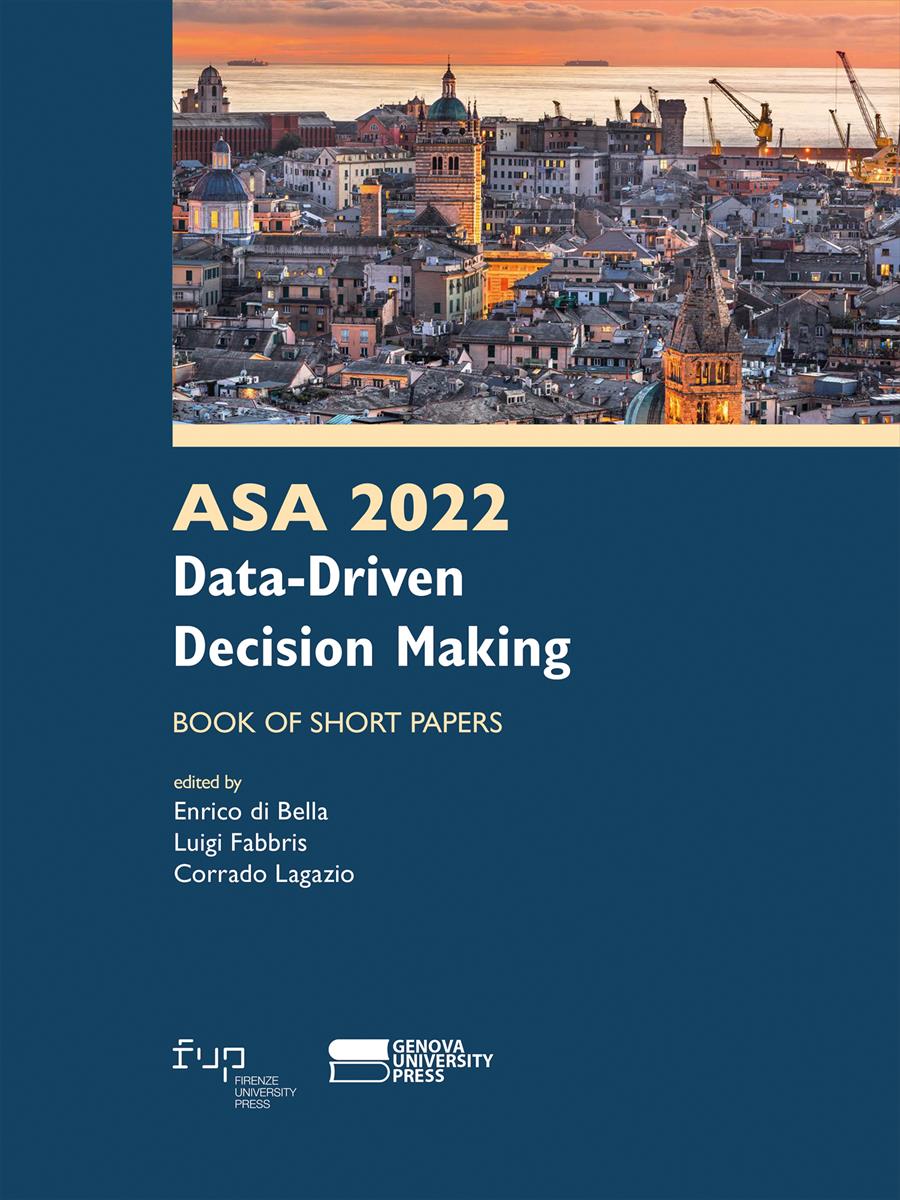- ASA 2022 Data-Driven Decision Making
- Edited by Enrico di Bella, Luigi Fabbris, Corrado Lagazio
Given N forecasting models, what to do?
- Fabrizio Culotta
- © 2023 Author(s) |
- CC BY 4.0
- DOI: 10.36253/979-12-215-0106-3.55
This work evaluates the forecasting performances of different models using data on Italian unemployment and employment rates over the years 2004-2022 at the monthly frequency. The logic of this work is inspired by the series of M-Competitions, i.e. the tradition of competitions organized to test the forecasting performances of classical and innovative models. Given N competing models, only one winner is selected. The types of forecasting models range from the Exponential Smoothing family to ARIMA-like models, to their hybridization, to machine learning and neural network engines. Model combinations through various ensemble techniques are also considered. Once the observational period is split between the training and test set, the estimated forecasting models are ranked in terms of fitting on the training set and in terms of their forecast accuracy on the test set. Results confirm that it does not exist yet a single superior universal model. On the contrary, the ranking of different forecasting models is specific to the adopted training set. Secondly, results confirm that performances of machine learning and neural network models offer satisfactory alternatives and complementarities to the traditional models like ARIMA and Exponential Smoothing. Finally, the results stress the importance of model ensemble techniques as a solution to model uncertainty as well as a tool to improve forecast accuracy. The flexibility provided by a rich set of different forecasting models, and the possibility of combining them, together represent an advantage for decision-makers often constrained to adopt solely pure, not-combined, forecasting models. Overall, this work can represent a first step toward the construction of a semi-automatic forecasting algorithm, which has become an essential tool for both trained and untrained eyes in an era of data-driven decision-making.
- Keywords:
- Forecasting performances,
- M-Competitions,
- Model types,
- Model ensemble techniques,
- Decision-making and forecast accuracy,
University of Genoa, Italy - ORCID: 0000-0002-3910-3088
- Assimakopoulos, V. and Nikolopoulos, K. (2000). The theta model: a decomposition approach to forecasting. International Journal of Forecasting, 16(4):521–530.
- Bergmeir, C., Hyndman, R. J., and Ben´ıtez, J. M. (2016). Bagging exponential smoothing methods using stl decomposition and box-cox transformation. International Journal of Forecasting, 32(2):303–312.
- Brown, R. G. (1956). Exponential smoothing for predicting demand. NBER.
- Chambers, J. M. and Hastie, T. J. (2017). Statistical models. In Statistical models in S, pages 13–44. Routledge.
- De Livera, A. M., Hyndman, R. J., and Snyder, R. D. (2011). Forecasting time series with complex seasonal patterns using exponential smoothing. Journal of the American Statistical Association, 106(496):1513–1527.
- Dissanayake, G., Peiris, M. S., and Proietti, T. (2016). State space modeling of gegenbauer processes with long memory. Computational Statistics & Data Analysis, 100:115–130.
- Holt, M. and Modigliani, J. (1960). Planning production, inventories, and workforce.
- Hyndman, R. J. (2020). A brief history of forecasting competitions. International Journal of Forecasting, 36(1):7–14.
- Hyndman, R. J. and Khandakar, Y. (2008). Automatic time series forecasting: the forecast package for r. Journal of Statistical Software, 27:1–22.
- Makridakis, S., Andersen, A., Carbone, R., Fildes, R., Hibon, M., Lewandowski, R., Newton, J., Parzen, E., and Winkler, R. (1982). The accuracy of extrapolation (time series) methods: results of a forecasting competition. Journal of Forecasting, 1(2):111–
- Makridakis, S., Spiliotis, E., Assimakopoulos, V., Chen, Z., Gaba, A., Tsetlin, I., and Winkler, R. L. (2021). The m5 uncertainty competition: results, findings and conclusions. International Journal of Forecasting.
- Peiris, M. and Perera, B. (1988). On prediction with fractionally differenced arima models. Journal of Time Series Analysis, 9(3):215–220.
- Petropoulos, F. and Makridakis, S. (2020). The m4 competition: bigger. stronger. better. International Journal of Forecasting, 36(1):3–6.
- Shaub, D. (2020). Fast and accurate yearly time series forecasting with forecast combinations. International Journal of Forecasting, 36(1):116–120.
- Svetunkov, I. and Boylan, J. E. (2020). State-space arima for supply-chain forecasting. International Journal of Production Research, 58(3):818–827.
- Svetunkov, I. and Kourentzes, N. (2018). Complex exponential smoothing for seasonal time series.
- Yapar, G., Yavuz, ˙I., and Selamlar, H. T. (2017). Why and how does exponential smoothing fail? an in depth comparison of ata-simple and simple exponential smoothing. Turkish Journal of Forecasting, 1(1):30–39.
Chapter Information
Chapter Title
Given N forecasting models, what to do?
Authors
Fabrizio Culotta
Language
English
DOI
10.36253/979-12-215-0106-3.55
Peer Reviewed
Publication Year
2023
Copyright Information
© 2023 Author(s)
Content License
Metadata License
Bibliographic Information
Book Title
ASA 2022 Data-Driven Decision Making
Book Subtitle
Book of short papers
Editors
Enrico di Bella, Luigi Fabbris, Corrado Lagazio
Peer Reviewed
Publication Year
2023
Copyright Information
© 2023 Author(s)
Content License
Metadata License
Publisher Name
Firenze University Press, Genova University Press
DOI
10.36253/979-12-215-0106-3
eISBN (pdf)
979-12-215-0106-3
eISBN (xml)
979-12-215-0107-0
Series Title
Proceedings e report
Series ISSN
2704-601X
Series E-ISSN
2704-5846
